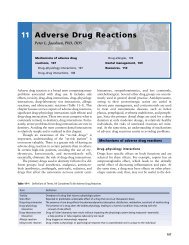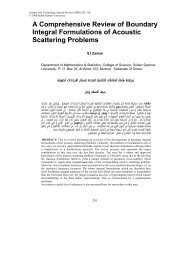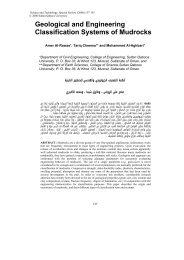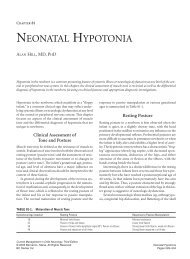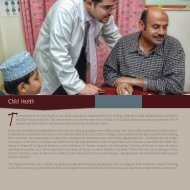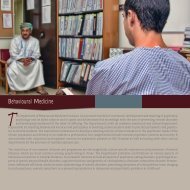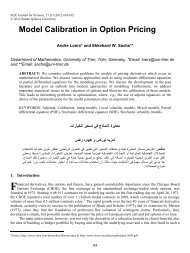Male Reproductive Toxicity - SQU Home
Male Reproductive Toxicity - SQU Home
Male Reproductive Toxicity - SQU Home
Create successful ePaper yourself
Turn your PDF publications into a flip-book with our unique Google optimized e-Paper software.
TABLE 8Case-Control Studies of Paternal EffectsType of Exposure/OccupationAssociation withExposure a Effect Ref.Printing industry (+) Cleft lip 144Paint (+) Cleft palate 144Paint + Damage to CNS b 145Solvents (+) Damage to CNS b 145Low-level radiation + Neural tube defects 146Organic solvents + Spontaneous abortion 147Aromatic hydrocarbons + Spontaneous abortion 147Dusts + Spontaneous abortion 147Radiation + Childhood leukemia 148Welding + Time to conception 149Agriculture (+) Child brain tumor 150Construction (+) Child brain tumor 150Food/tobacco processing (+) Child brain tumor 150Metal + Child brain tumor 150Lead (+) Spontaneous abortion 151Lead (+) Congenital defects 152Ethylene glycol ether + Abnormal spermiogram 153Metals + Cadmium in semen 154a(+): marginally significant association; +: significant association.bCNS = central nervous system.Source: Modified from Taskinen, H., Scand. J. Work Environ. Health, 16, 297, 1990.and other data sources. Like population-based studies, case-control studies provide thestatistics needed to detect a rare event; however, in this type of study individual bias mayyield misleading results. A person who has experienced an adverse outcome may report anexposure more readily than one with no history of reproductive dysfunction. As Levindescribes, 81 a couple that has recently experienced a stillbirth or congenitally malformed childwill be more inclined to search for a previous toxic exposure as the source. Another potentialsource of bias in these studies exists with the interviewer, who should be “blind” to thereproductive status and the exposure classification of the respondent.2.3.4 Standardized Fertility RatioThe standardized fertility or birth ratio (SFR) (Table 9) provides a comparison of thenumber of observed births within a population to the number of expected births. The lattervalue is obtained using the birth rate of an external population. To monitor a specific workforcegroup, Wong 82 uses a simple standardization method that provides noninvasive, readilyavailable data. His method uses a couple’s reproductive history to measure male fecundity.The number of expected births is obtained from the birth rate for U.S. women of the sameage group. There are some problems with this simplified approach. Because the U.S. birthrate as collected by the National Center for Health Statistics does not take into accountmarital status, birth control, or frequency of intercourse, 83 the potential exists for a positiveor negative bias in making such comparisons. Wong’s method erroneously assumes all womento be equally libidinous and fecund. Additionally, because only married men are evaluated inSFR studies, there are age-related restrictions in the data as well as a likely underestimate ofthe number of children born out of wedlock. Some researchers have tried to correct for thesevariations in the population using different models. 83,84 It appears that the SFR overestimatesbirth rate in both control and exposed populations, even when a reduction in semen quality© 1999 by CRC Press LLC





